Craig Comer's Blog, page 15
April 7, 2014
Castle Orchardton Tower: What Happened Here?
A real place in the realms: What Happened Here?
Writing prompt, history assignment, inspiration, or just something to enjoy. Your choice! If you come up with anything you want to share, post it in the comments.
Here’s a hint.
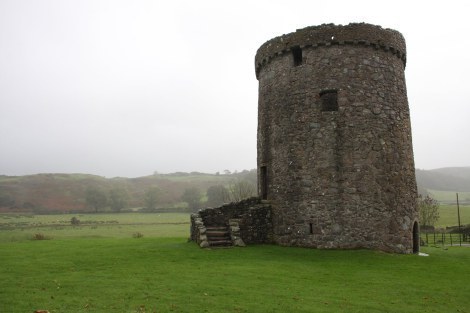
Castle Orchardton Tower by RigelZoo News


April 3, 2014
The Six Days: Witch at The Gate
Adan was on guard by himself when everything changed. The Gate had been quiet for fifteen years, standing in the center of the circle of white stone pillars, a doorway to nowhere. The Gate had been quiet for so long that the job of guarding it, which had been an honored and sought-after position in the days before it had been sealed, was relegated down the ranks to the lowest and weakest: one young witch alone, and watching, and waiting. That was Adan—he had finished his training at the Council the year before, graduating at the bottom of his group, barely making it through the trials. He was useless with a sword and his spellwork was sloppy. He had never said it out loud but the truth was: he was relieved to have been posted to guard the Gate, where nothing ever happened.
It was summer in Emanu but it was the end of summer, and it was chilly. Adan, who was wrapped tightly in his standard-issue Council grey cloak, was debating whether or not he should make a fire. He was kneeling over a pile of kindling, snapping his cold fingers to try to spark a flame, when it happened: a twitch in the air, a tension, a tightening.
Adan looked up sharply. The Gate was a site of oldest magic—magic was drawn to it, moving in currents about it. For fifteen years the Gate had been sealed and the magic had been still. But now something had shifted. That was what Adan had felt: the shift. He had been stationed alone at the Gate for weeks and everything had been silent and still. Something had changed.
There was an enchantment around the circle, Adan’s doing, that kept everyone and everything out. No one but the guard could go near the gate; so any magic in the circle had been done by Adan. And he hadn’t done anything.

His pack with his food and water and his sword was resting at the base of one of the columns, and now he took the sword in hand. His other palm he opened, conjuring a light, and, raising her palm, he went to stand in front of the Gate. It looked the same as always. A door that didn’t open.
There was a second shift in the Gate, and this one came with a rumble that shook the plains. A mile to the east where the mountains rose up there was a forest and a flock of birds took of suddenly into the night sky, abandoning their nests. Then everything was still again.
Adan frowned and lifted his light higher, circled the Gate. Something was off, but he wasn’t sure if it was worth reporting. He decided to wait until morning to send a message.
“A cold night to be out without a fire,” a voice observed, and Adan jumped, startled. He had been out there on his own for a long time; the last time he had seen anyone had been several weeks previous, when they had dropped off supplies. There wasn’t supposed to be anyone for another two weeks.
“Who’s there?” he said, holding out his hand, seeking out the speaker with the light. His voice was hoarse with disuse and he cleared it before saying, “Show yourself. Please.”
From the night emerged a woman. Even from that distance, even when she was half-hidden in darkness, Adan could tell another Council witch when he saw one. They had an air, a way of carrying themselves and besides, he always knew one of his own. He relaxed a little. “Sister,” he called. “What brings you out here?” In the middle of the night, miles and miles from anything, he didn’t ask—to tell the truth, with the stirrings of the magic around the Gate he was relieved to see someone.
The other witch approached, as close as she could. She wore a dark blue cloak and under her hood long blonde hair fell very beautifully over her shoulder against the midnight fabric. She smiled. “I’m Rebecca,” she said. “I would be grateful for some food and water.”
Adan hesitated. He wasn’t supposed to let anyone into the circle around the Gate.
Rebecca went on. “I can see you’re having trouble making a fire,” she said, and Adan blushed, wondering how long she had been nearby. “I know cold fingers aren’t good for making spells. I would be happy to help.”
There was an electric shock and then a sudden absence as Adan lowered the spell around the circle.
It wasn’t long before Rebecca had the fire going—she glanced at the kindling he had gathered and it burst into flame. Adan felt a fresh surge of shame. They sat around it together, grateful for the warmth and the light. Adan had bread and dried fruit and water and he shared these with the traveler. He had laid his sword aside—a sister from the Council meant company, not threats.
“What brings you all the way out here?” he asked a second time as Rebecca broke off the end of the bread and hungrily tore off a bite with very, very white teeth. She had taken down her hood and Adan saw that her eyes were blue. She was incredibly fair and frighteningly delicate, a branch coated with ice after a storm. The vibrations of magic around her were incredibly strong.
“Just travel,” Rebecca shrugged. She looked up at the Gate, whiter than ever with the moon hovering just above. “I’ve never seen it,” she said softly.
Adan was surprised. “Really?” he said. “You must have finished training years ago.” The long hair was the give away; all the female witches who were still in service at the Council had to keep their hair short at their ears. “I’d have thought you were old enough to remember when it was open.”
Rebecca shook her head, stuffing her mouth with dried fruit. She was eating like she hadn’t seen a meal in a week, Adan thought, and wondered how far she had traveled. “It was closed when I was twelve.”
“Where did you do your service?” Adan asked curiously, and Rebecca said, “I passed the trials when I was ten, and then I studied with my mother.”
Adan was impressed; he had heard about that, in cases of witches whose mothers or fathers were particularly powerful and particularly high in the Council, but to pass the trials at the age of ten meant that Rebecca had studied magic since she was old enough to walk. No wonder, he thought, she did spells so effortlessly—to the very practiced it was like breathing, a sixth sense used unconsciously the way Adan used his eyes and his ears. Magic must have run very strong in Rebecca’s family.
“Who was your mother?” he asked curiously. “I must have heard of her.”
Ignoring this, Rebecca took a long drink of water and said, “What’s the date?”
Startled but amiable Adan thought a minute and said, “Three before.”
The traveler wiped her mouth. “And has the Gate opened?” she asked, as though it was the most natural next question in the world.
For a second Adan gaped at her, but before he could say anything, he was already dead. His stiff body fell back onto the snow next to his pack and his sword. The firelight danced off eyes that were still wide with surprise.
Rebecca straightened up, dusted bread crumbs off of her knees. She had snapped very suddenly, unable to contain herself. It was an important night for her and everything needed to go very particularly and he had been in the way. If you were going to kill a young boy in cold blood it was kindest to do it while he was distracted. Rebecca thought herself a very kind killer; Adan had been very distracted, completely unsuspecting; he still gripped the water bottle in cold fingers. Rebecca pried it away and drained the last drop. She was always thirsty when she was excited.
She glanced at the sword on the ground next to the dead boy and decided to leave it. She looked up on at the Gate. It was three days before Starset in the hundreth year of Io’s reign as Queen.
On the other side it was June twenty-first, two-thousand and eight.
The day Gate was to reopen.
Now Rebecca reached out a hand and touched the pillars of the Gate. They were very much alive under her fingertips. The cold night wrapped around her, the wind urging her forward. Rachael might be dead, but Rebecca was going to finish what she had started. She glanced at the fire—it went out and everything was dark.
Pulling her hood up around her face, Rebecca went through the Gate.
In the other world, a boy named Jamie Carpenter opened a book of spells that had been collecting dust in his attic for fifteen years.
 The Six Days
is available from Amazon, Barnes and Noble, and directly from the publisher at giantsquidbooks.com.
The Six Days
is available from Amazon, Barnes and Noble, and directly from the publisher at giantsquidbooks.com.
Anna Carolyn McCormally currently manages a small used bookstore in Washington, D.C.. She has a tattoo of the Deathly Hallows and blogs about YA fiction at www.giantsquidbooks.com. Her short fiction and poetry has been published in pacificREVIEW, Quantum Fairy Tales and 3 am magazine. Follow her on Twitter @mccormallie.
You can find more about The Six Days here:
http://giantsquidbooks.com/books/
https://www.goodreads.com/book/show/20560327-the-six-days


March 27, 2014
Summer’s Shadow
 Sierra stood on the water’s surface but wasn’t sinking. It felt like standing on a soaked sponge used to wash dishes. Looking at her body a brilliant white light shone from every part of it, illuminated the cavern and even the depths of the water.
Sierra stood on the water’s surface but wasn’t sinking. It felt like standing on a soaked sponge used to wash dishes. Looking at her body a brilliant white light shone from every part of it, illuminated the cavern and even the depths of the water.
Her physical body sank to its death. The shining silver cord connecting her two halves together breaking off from her bellybutton, sinking with her body.
Soon she discovered she had stumbled upon a mysterious realm known as The Void.
Can Sierra be happy sharing her life between both realms, or will she be forced to choose one over the other forever?
 Craig MacLachlan lives in Post Falls, Idaho, USA and is married to Christina. Craig’s passion in life is to tell stories. He started writing at a young age and reads books every chance he gets. His first completed Young Adult novel, SUMMER’S SHADOW, Book One of ‘Sierra Winters and The Void’, a planned trilogy, is out now and available from online booksellers and high street bookstores by order worldwide. Craig is also working on a Young Adult horror novel and has two short films, “Roger” and “Marbles: A Love Story” he co-wrote with the director. Craig won third place in a one act screenwriting competition sponsored by the Maricopa County Community College District (MCCCD) Creative Writing Competition for 2011-12. Craig is also a story contributor for Young Adult Magazine as well as an article contributor for Zen Life. Craig enjoys, among others, reading, treasure hunting and exploring – and can also name all fifty states in alphabetical order!
Craig MacLachlan lives in Post Falls, Idaho, USA and is married to Christina. Craig’s passion in life is to tell stories. He started writing at a young age and reads books every chance he gets. His first completed Young Adult novel, SUMMER’S SHADOW, Book One of ‘Sierra Winters and The Void’, a planned trilogy, is out now and available from online booksellers and high street bookstores by order worldwide. Craig is also working on a Young Adult horror novel and has two short films, “Roger” and “Marbles: A Love Story” he co-wrote with the director. Craig won third place in a one act screenwriting competition sponsored by the Maricopa County Community College District (MCCCD) Creative Writing Competition for 2011-12. Craig is also a story contributor for Young Adult Magazine as well as an article contributor for Zen Life. Craig enjoys, among others, reading, treasure hunting and exploring – and can also name all fifty states in alphabetical order!
SUMMER’S SHADOW is Craig MacLachlan’s first published work.
Find Craig MacLachlan as his work here:
Craig MacLachlan profile on MediaAria CDM: http://www.mediaaria-cdm.com/craig-maclachlan/
Craig MacLachlan’s profile on Goodreads: http://www.goodreads.com/author/show/5805745.Craig_MacLachlan


March 20, 2014
An Apprentice’s Guide to Erosmancy
From the Book: An Apprentice’s Guide to the Colleges of Magic, Vol. 5, by Archmage Radu Havandrum
Modern practitioners of the Craft know the school of Erosmancy as one of several schools within the College of Enchantment. Erosmancers focus on the art of sex magic, harnessing the metaphysical energy of sexual attraction and activity to power their spells and rituals. While the uninitiated might consider Erosmancy a product of our decadent modern culture, the school has a long, though at times controversial, history in the Craft.
Most people do not realize that Erosmancy was originally a school within the College of Necromancy. In fact, it was the first dedicated school within the College of Necromancy. Like all Necromancers, Erosmancers were focused on the study of life and death. Early practitioners dealt specifically with the beginning of life through the study of procreation. Erosmancers were employed to prevent stillbirths, prevent unwanted pregnancies, guarantee healthy offspring, avoid birth defects, and ensure male heirs to protect the lineages of powerful families.
The groundbreaking research of Rank Two Erosmancer Andrej Loncar (1215-1496) in his work The True Nature of the Dhampiric State and What It Means to Both the Living and the Undead, first published in 1375, did more than increase our understanding of vampires. It demonstrated for the first time that sexual energy could be both Symbiotic and Parasitic. This research would make its way into a variety of disciplines, from Warlocks looking for new ways to combat Incubi and Succubi to mundane psychologists treating the victims of sexual abuse.
Loncar’s work, however, also opened the door to new areas of research that would ultimately lead to a schism with the College of Necromancy. It is believed that Loncar’s research was used by Haermomancer Chana Magus during her study of psychic vampires; research that ultimately lead to the purging of the school.* In 1786, the school officially broke rank with the College of Necromancy. A final truce was settled in 1806 when the school returned to the Colleges of Magic as part of the College of Enchantment.^
* Fray, Arlene. Haemomancy: Fragments on a Forbidden Art. 1st ed. 2. Rome, Italy: Eden House Publishing Company, 1998. 145. Print.
^Penderhaus, Maxwell. Sex, Death, and War: A Historical Account of the Necromantic Schism of 1786 . 2nd ed. New York City, NY: Draconia Press, 2007. 212. Print.

About Julie Ann Dawson’s Nancy Werlock’s Diary series:
Dr. Nancy Werlock is one of the most successful marriage counselors in the Delaware Valley. Some credit her uncanny empathy. Some credit her quick wit and quirky sense of humor. But Nancy also has a unique set of skills she didn’t learn from any psychology training. Nancy is a sixth generation demonologist, and though she upset her mother when she decided to pursue a mundane professional instead of taking up the family business, she’s kept her magical skills sharp by integrating a few choice spells into her counseling practice.
Nancy Werlock’s Diary follows Nancy’s daily trials and troubles as she struggles to juggle her professional obligations with her familial ones. Each set of stories is a stand alone collection that provides a window into the life of a modern day warlock. And while Nancy may have a few arcane tricks at her disposal, her problems are surprisingly relatable (even when her mother is giving her a guilt trip from beyond the grave).
You can find more about Nancy Werlock here:
https://sites.google.com/site/nancywerlock/
http://www.bardsandsages.com/speculative_fiction/nancy_werlocks_diary


March 13, 2014
Serendipidus – A Dying Earth. Bummer.
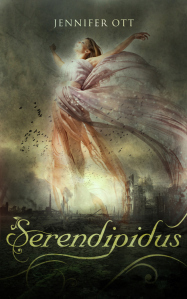
Medusa Dominatrix not only wanted to dominate Mother Earth; she planned to stop her in her tracks. The plan was simple – one environmental catastrophe after another – nuclear explosions, oil spills, brush fires and trash dumps. These events set off a reaction that struck frenzy in all creatures. Insects scurried from underground and even birds felt the vibrations on the earth. Every animal sensed it; except for the smartest – man.
The cataclysm brought tornado force winds and lifted the city’s trash into a funnel that blew over Liberty Harbor. Lady Liberty’s torch broke from her grasp and plummeted onto a ferry below. Steel beams busted, causing skyscrapers to crumble. The earth rumbled beneath the streets, rupturing water mains, gas pipes and sewers. Leaves blew from trees and trunks uprooted. When it ended, there was silence.
Life emerged slowly to chaos, yet commuters headed to work without much care. As the day wore on, few noticed the sun failed to rise. It grew obvious; the earth had stopped rotating. Panic filled hearts as life faded. Some looted for food, while others sought suicide, but a few brave souls remained steadfast with hope.
Mother Earth was resilient; she had healing ability beyond the concept of her greatest foes. While many mourned her life, others rallied around her resurrection. For her to live again, it would take a conscious effort to focus on her healing. As a growing number set their intention, the planet was renewed.

Inspiration comes from watching way too much Monty Python. The abstract and the absurd way of looking at normal life, not only offers humor, but questions many problems in society in a light-hearted manner. If we can laugh at ourselves, if we can laugh at life, problems do not seem quite so difficult to tackle. In fact, problems are not as complicated as they seem; everything is very simple. If you can laugh at it, write about it and read about it, most likely one would think about it.
 Author Jennifer Ott has written several satire fiction, Wild Horses, The Tourist and two non-fiction books Love and Handicapping and Ooh Baby Compound Me! Her latest book about the homecoming of a Vietnam Veteran, Edge of Civilization will be released soon.
Author Jennifer Ott has written several satire fiction, Wild Horses, The Tourist and two non-fiction books Love and Handicapping and Ooh Baby Compound Me! Her latest book about the homecoming of a Vietnam Veteran, Edge of Civilization will be released soon.
Jennifer Ott lives in Long Beach, California, enjoys the sun, the sand, the surf and lots of Mexican food.
https://www.facebook.com/Serendipidus
https://twitter.com/JenniferLOtt
http://www.pinterest.com/superjenius24/serendipidus/
http://www.superjeniuspublications.com/jennifer_ott/serendipidius
Giveaway!
There is a tour-wide giveaway during this tour for a $25 Amazon Gift Card. Follow the link for a chance at winning!


March 6, 2014
Dirks in the Details
Inspiration can come from anywhere: from visiting the toy towers of Bodiam Castle, to an overheard scrap of conversation. Setting is no different, in this regard, than character or plot.
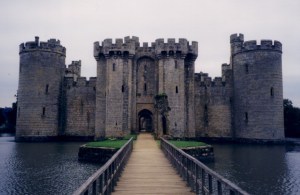
Bodiam Castle
An image has stuck with me from the novel Rob Roy, a detail thrust within a block of vivid description that helps imagine the world. While stopping at a public-house, our narrator, Frank Osbaldistone, comes across a group of Highlanders. Each man has his dirk stuck in the table before him, and woe to anyone who dare interrupt their private conversation. Within that detail lies menace and foreboding, custom and culture. It is not just a threat, it is their way of doing things, and this duality heightens the setting.
Here is the passage:
“The other mountaineer was a very tall, strong man, with a quantity of reddish hair, freckled face, high cheek-bones, and long chin—a sort of caricature of the national features of Scotland. The tartan which he wore differed from that of his companion, as it had much more scarlet in it, whereas the shades of black and dark-green predominated in the chequers of the other. The third, who sate at the same table, was in the Lowland dress,—a bold, stout-looking man, with a cast of military daring in his eye and manner, his riding-dress showily and profusely laced, and his cocked hat of formidable dimensions. His hanger and a pair of pistols lay on the table before him. Each of the Highlanders had their naked dirks stuck upright in the board beside him,—an emblem, I was afterwards informed, but surely a strange one, that their computation was not to be interrupted by any brawl. A mighty pewter measure, containing about an English quart of usquebaugh, a liquor nearly as strong as brandy, which the Highlanders distil from malt, and drink undiluted in excessive quantities, was placed before these worthies. A broken glass, with a wooden foot, served as a drinking cup to the whole party, and circulated with a rapidity, which, considering the potency of the liquor, seemed absolutely marvellous. These men spoke loudly and eagerly together, sometimes in Gaelic, at other times in English.”
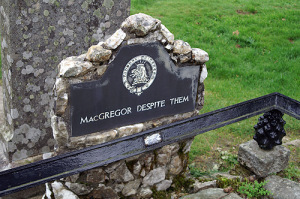
Rob Roy’s Grave
When writing a scene for my short story “Aelfie of Glen Coe”, the image from Rob Roy popped into my head, and I knew my Highlanders would be introduced by the same little cultural detail. But in this context, the men use the custom to ward off the intrusion of a queen’s agent, a nefarious Reckoner, their blades drawn bare in silent warning.
“Scampering across the roadway, Aelfie pulled her cowl tight around her chestnut locks. She spied a steam carriage in the yard on the far side of the house, a monster of steel and wood, with copper tubes lashed in a lattice across its flank and a charred snout thrusting upward from its roof. A man in a gray suit shoveled coal into its rear hatch. Another lounged against a low fence, fiddling with a chronometer. His arms were sleeved in boiled leather plated in bronze. Aelfie found herself staring. She’d seen such things before, but always a curiosity overcame her to know more, to study every little knob and lever.
The man with the shovel glanced at her, and she hurried inside. The common room of the wayfarers’ house held a trio of long wooden tables. A fire warmed the air from a stone hearth, over which hung the cooking pot. Withered beams sagged so low Aelfie had to duck to clear the threshold. A pair of herdsmen huddled in a corner, highlanders by their brawn and scruff. Their tartan trews were red striped with black and yellow. They’d thrust a dirk into the table between them, an old custom requesting privacy.”
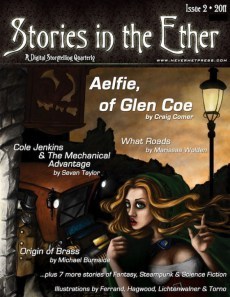
Aelfie of Glen Coe
You can read Sir Walter Scot’s novel at Project Gutenberg, who’ve hosted all of his public domain works.
“Aelfie of Glen Coe” was published in Stories in the Aether from Nevermet Press, and while the publisher has since closed, a free version of the story is still available here.


February 27, 2014
Baldairn Motte, Part II
When King Baelhairn learned of the jewel stolen away from his mine, he made an example of Garen and Jael. They were hung from the walls of Baldairn Motte for all to see, and the fist-sized emerald Garen had unearthed was set into a new crown for King Baelhairn to wear. Why this single act sparked rebellion after so many years of dominion is unclear. Some tales suggest Jael cursed the Baeldan King and called upon her people to rise up as the noose was placed over her head.
Whatever the reason may have been, the Thralls revolted. King Baelhairn was slain and Baldairn Motte was destroyed in the first year of the war, as the Thralls, dressed as Green People, raided the stronghold en masse. The Baeldan lords across the kingdom took up the fight, each intent on staking their own claim to the throne and once again subjugating the common folk. The war dragged on for years, with numerous battles waged at Baldairn Motte to the same result; whichever Baeldan lord placed himself on the throne at Baldairn Motte was slain. Legends grew of the Amber Maiden’s curse, of the Green People emerging from the forests to take their revenge upon the Baeldans. War turned to blight as fields and crofts were left unworked, and The Blight Winter killed more than had died in battle. The Baeldan lords shrank in number and finally turned to the aid of the foreign lords in the south who worshiped the Passions.
Order was restored. The Kingdom of Baelda was absorbed by the new realm in the south. The common folk returned to their villages and farms and crofts. Of the Baeldan lords, only the Hairng line maintained prominence in ruling the land; Hairng the sole remaining descendants of King Baelhairn, The Last King of Baelda.
Baldairn Motte itself was abandoned and became a place of hauntings and legend. The ghost of the Amber Maiden—the Motte Witch—was said to kill any who looted the ruins in search for the great emerald that was gifted and taken away from her. And there were other ghosts, too, the ghosts of the Thralls, descendant of both the Fairie and the Baeldans, who died in battle there for their freedom.
With such a history, it is perhaps appropriate then that nearly a thousand years later, it was at the ruins of Baldairn Motte that Audwin Ernmund, Lord of Hairng, would fight to put a descendant of the Baeldan line on the throne once again. This time, however, the Baeldan Lord was not fighting to enslave his people, but rather free them from the yoke of the south.
Baldairn Motte is the focus of the mosaic fantasy novel, The Roads to Baldairn Motte. The novel, written by Garrett Calcaterra, Ahimsa Kerp, and Craig Comer takes on three different viewpoints of the same epic confrontation.


February 20, 2014
Heroes of the Faerie War
“So…” Father said, folding his morning newspaper.
Violet’s breath caught in her throat and she held her spoon inches from her mouth.
“Your birthday is coming up,” Father said.
Only in one week and two days, and this was the first time either of Violet’s parents had brought it up. She forced the spoon into her mouth and began crunching away on her cereal. No need to give him the impression that she’d been waiting for this conversation for well over a month.
“Mmm hmmm.” Even in her excitement, Violet knew better than to talk with her mouth full. She’d seen her older brother make that mistake too many times before he went off to college.
“Have you thought about what you’d like to do?”
Violet dropped the spoon into her bowl, reached into the back pocket of her jeans, pulled out the brochure, and slid it across the table to her father. He glanced down, frowning, at the portion she’d circled.
* * *
“As we honor the soldiers who defended us during our darkest hours, we must also remember the artists who gave our soldiers the time they needed to preserve our way of life. These artists risked sanity and life just as the men and women in our armed forces, ad did it with little or no training, and often with no support, not even from friends and family. These are the true heroes of the Faerie War.” – General Sherman Bishop
The Champion’s tour in San Francisco is the finest and most secure artist tour in the country. While much of the tour of the young lady’s work exists in the Wild Zones of San Francisco, due to the importance of this artist’s place in the Faerie War, the United States Government has spared no expense to ensure the safety of citizens wishing to tour this young lady’s work. You can be absolutely certain of security as you follow her footsteps as she attempted to prevent the war from ever happening.
You may have considered visiting war sites: the crater of Washington DC, the Central Park Fortress, or perhaps even take the escorted flight through the Grand Canyon where the last holdouts of Unseelie faeries still fight, refusing to acknowledge the war is over. As exciting as those tours might be, they do not compare to the mystery and wonder of seeing the artist’s work from her first sketches as a fledgling artist to her graffiti work and paintings where she struggled to keep the faerie from our world. This artist’s work is the greatest and most tragic battle in the whole of the Faerie War and it deserves to be seen.
* * *
“Please Dad?” Violet said.

M. Todd Gallowglas
M Todd Gallowglas is the bestselling author of the Tears of Rage and Halloween Jack series. This piece ties into the first two installments of DEAD WEIGHT, his serialized near-future, urban-fantasy, war thriller account of a war between the United States and the faerie of ancient Irish Mythology. DEAD WEIGHT: The Tombs is currently available in eBook, and part two DEAD WEIGHT: Paladin is coming soon.
To find out more about M Todd Gallowglas, head over to his official website: www.mtoddgallowglas.com


February 18, 2014
Reputation Books Giveaway!
Reputation Books
February 13, 2014
5 Books on Writing Fantasy Worlds
Here at Realm Tramper, we strive to not only give you some great accounts and insight into distant places, but a full spectrum of all things Setting. Or the “M” of Orson Scott Card’s M.I.C.E. quotient. To find out what that’s all about, you’ll have to check out his book!
Not in any order, here are 5 books containing some great advice, notes, and commentary on how to build fantasy worlds.
How to Write Science Fiction & Fantasy by Orson Scott Card

Kobold Guide to Worldbuilding edited by Janna Silverstein

Wonderbook: The Illustrated Guide to Creating Imaginative Fiction by Jeff VanderMeer

The Writer’s Complete Fantasy Reference from Writer’s Digest Books

World-Building by Stephen L. Gillett







